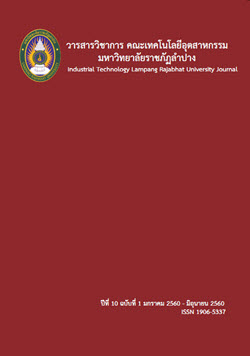ผลของตัวแบบที่ส่งผลต่อความสามารถในการชำระสินเชื่อ ของสมาชิกสหกรณ์เครดิตยูเนี่ยน
Keywords:
เหมืองข้อมูล, สินเชื่อ, สหกรณ์เครดิตยูเนี่ยน, Data mining, Finance, Cooperative credit unionAbstract
การวิจัยในครั้งนี้ได้ทำการศึกษาเกี่ยวกับการนำเทคนิคทางด้านเหมืองข้อมูล มาประยุกต์ใช้ในการระบุดัชนีที่เกี่ยวข้องกับความสามารถในการชำระสินเชื่อของสมาชิกสหกรณ์เครดิตยูเนี่ยน เพื่อทำการค้นหาว่าควรจะต้องพิจารณาอะไรบ้างในการอนุมัติสินเชื่อ ซึ่งจะทำให้มีอัตราการเกิดหนี้สูญที่ลดลง ซึ่งจากการรวบรวมข้อมูลจากสหกรณ์เครดิตยูเนี่ยนในเขตอำเภอเมืองจังหวัดลำปางจำนวน 5 แห่ง พบว่าสหกรณ์แต่ละแห่งจะมีหลักเกณฑ์ในการให้อนุมัติสินเชื่อที่คล้ายคลึงกัน โดยสามารถกำหนดเป็นปัจจัยที่เกี่ยวข้องในการพิจารณาสินเชื่อจำนวน 19 ปัจจัย และเมื่อนำมาวิเคราะห์โดยวิธีการ Evolutionary Selection พบว่ามีปัจจัยที่มีผลกระทบโดยตรงกับการชำระสินเชื่อของสมาชิกเพียง 12 ปัจจัย จากนั้นจึงนำปัจจัยที่ได้มาทำการสร้างเป็นตัวแบบด้วยเทคนิคต้นไม้ตัดสินใจ (Decision Tree) เทคนิคเบย์เซียนแบบง่าย (Naive Bayes) และเทคนิคการค้นหาเพื่อนบ้านที่ใกล้ที่สุด k ตัว (K-Nearest Neighbors) และนำตัวแบบที่สร้างขึ้นด้วยเทคนิคข้างต้นมาทำการทดสอบด้วยวิธีการทดสอบแบบไขว้ (Cross Validation) แล้วทำการวัดค่าความถูกต้อง (Correct) ค่าความแม่นยำ (Precision) ค่าความระลึก (Recall) และค่าความถ่วงดุล (F - Measure) โดยในการทดสอบเพื่อหาค่าตัวแบบที่เหมาะสมจะนำไปใช้ได้ใช้ข้อมูลตัวอย่างจำนวน 200 ตัวอย่าง จากผลการทดสอบพบว่าตัวแบบที่สร้างขึ้นด้วยวิธีการต้นไม้ตัดสินใจ (Decision Tree) ให้ผลลัพธ์ในการทดสอบที่ดีที่สุด โดยมีค่าความถูกต้องที่ร้อยละ 95.96 มีค่าความแม่นยำที่ร้อยละ 95.71 มีค่าความระลึกที่ร้อยละ 91.67 และมีค่าความถ่วงดุลที่ร้อยละ 91.94 ทั้งนี้เมื่อนำไปใช้ในการทดสอบกับข้อมูลสมาชิกที่ขอสินเชื่อและติดตามข้อมูลการชำระสินเชื่อพบว่า มีสมาชิกเพียง 2 ราย จาก 5 ราย ที่ได้รับการประเมินว่ามีโอกาสเกิดหนี้สูญเท่านั้นที่มียอดค้างชำระสินเชื่อ
Effects of Models that Affect their Ability to Repay Loans of Member in Credit Union Cooperative
This study was conducted using the implementation of data mining techniques which were applied to identify indices related to the ability of credit union members to repay loans. By finding out what should be considered in approving loans will lead to a lower rate of bad debt. The data was collected from 5 credit union cooperatives in the Muang District of Lampang Province. Each co-operative has similar lending guidelines. There are 19 factors that can be defined as relevant in determining the loan amount. When analyzed by the Evolutionary Selection method, there are only 12 factors that directly affect the loan payment of members. Then build models with different techniques, including Decision Tree, Naïve Bayes and K-Nearest Neighbors and then bring the model created with the above techniques to the test, Cross Validation measures the accuracy, accuracy, recall, and F-Measure, Precision, Recall and F-Measure values. In the tests to determine the proper way to apply a sample of 200 specimens. The model created by the Decision Tree technique were tested for the best results. The correct value is 95.96%, precision value is 95.71% and the recall value is 91.67% and f-measure is 91.94%. When applied to the test with member data and track credit repayment data, it was found that only 2 out of 5 members have been assessed for possible bad debts with outstanding loans.






